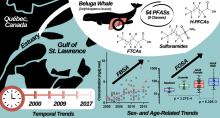| Title | Malformations of the endangered Chinese sturgeon, Acipenser sinensis, and its causal agent. |
| Publication Type | Journal Article |
| Year of Publication | 2009 |
| Authors | Hu, J, Zhang, Z, Wei, Q, Zhen, H, Zhao, Y, Peng, H, Wan, Y, Giesy, JP, Li, L, Zhang, B |
| Journal | Proc Natl Acad Sci U S A |
| Volume | 106 |
| Issue | 23 |
| Pagination | 9339-44 |
| Date Published | 2009 Jun 09 |
| ISSN | 1091-6490 |
| Keywords | Animals, China, Fishes, Organotin Compounds, Trialkyltin Compounds, Water Pollutants, Chemical |
| Abstract | The anadromous Chinese sturgeon (Acipenser sinensis) is endangered and listed among the first class of protected animals in China. The possible causes for the decline of this species are the effects of synthetic chemicals, and loss of critical habitat. Chinese sturgeon in the Yangtze River have accumulated triphenyltin (TPT) to 31-128 ng/g wet weigh (ww) in liver, which is greater than the concentrations of tributyltin (<1.0 ng/g ww). Maternal transfer of TPT has resulted in concentrations of 25.5 +/- 13.0 ng/g ww in eggs of wild Chinese sturgeon, which poses a significant risk to the larvae naturally fertilized or hatched in the Yangtze River. The incidence of deformities in fry was 7.5%, with 1.2% of individuals exhibiting ocular abnormal development, and 6.3% exhibited skeletal/morphological deformations. The incidences of both ocular and skeletal/morphological deformations were directly proportional to the TPT concentration in the eggs of both the Chinese sturgeon and the Siberian sturgeon (Acipenser baerii) in controlled laboratory studies. The rates of deformities in the controlled studies were consistent with the rates caused at the similar concentrations in eggs collected from the field. Thus, TPT is the causal agent to induce the malformation of larvae of Chinese sturgeon. The incidence of deformed larvae of Chinese sturgeon is an indicator of overall population-level effects of TPT on Chinese sturgeon, because TPT at environmentally relevant concentrations can result in significantly decrease both quality and quantity of eggs and spawning frequency of fish. |
| DOI | 10.1073/pnas.0809434106 |
| Alternate Journal | Proc. Natl. Acad. Sci. U.S.A. |
| PubMed ID | 19470453 |
| PubMed Central ID | PMC2695053 |
Environmental Chemical Biology

